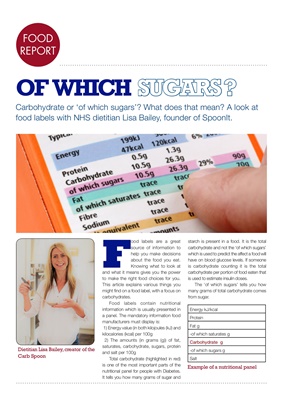
LIVINGLIVING
OF WHICH SUGARS ?
Carbohydrate or 'of which sugars'? What does that mean? A look at
food labels with NHS dietician Lisa Bailey, founder of SpoonIt.
FOOD
REPORT
F
ood labels are a great
source of information to
help you make decisions
about the food you eat.
Knowing what to look at
and what it means gives you the power
to make the right food choices for you.
This article explains various things you
might find on a food label, with a focus on
carbohydrates.
Nutritional panel
Food labels contain nutritional information
which is usually presented in a panel.
The mandatory information food
manufacturers must display is:
1) Energy value (in both kilojoules (kJ)
and kilocalories (kcal) per 100g
2) The amounts (in grams (g)) of fat,
saturates, carbohydrate, sugars, protein
and salt per 100g
Total carbohydrate (highlighted in red)
is one of the most important parts of the
nutritional panel for people with Diabetes.
It tells you how many grams of sugar and
starch is present in a food. It is the total
carbohydrate and not the 'of which sugars'
which is used to predict the affect a food will
have on blood glucose levels. If someone
is carbohydrate counting it is the total
carbohydrate per portion of food eaten that
is used to estimate insulin doses.
The 'of which sugars' tells you how
many grams of total carbohydrate comes
from sugar.
Energy kJ/kcal
Protein
Fat g
-of which saturates g
Carbohydrate g
-of which sugars g
Salt
Protein 8g
Fat g 3g
-of which saturates g 1g
Carbohydrate g 30g
-of which sugars g 3g
Salt 0.3
Look at the nutritional panel below.
The 'of which sugars' is 3g. This means
out of 30g of total carbohydrate 3g (10%)
is from sugar.
Unfortunately the 'of which sugars'
doesn't differentiate between free sugars
(previously known as added sugar)
and natural sugars, so from a health
perspective it's important to consider the
food you are eating, as we should limit
free sugar to under 30g per day.
Other types of carbohydrate are
added to the nutritional panel on a